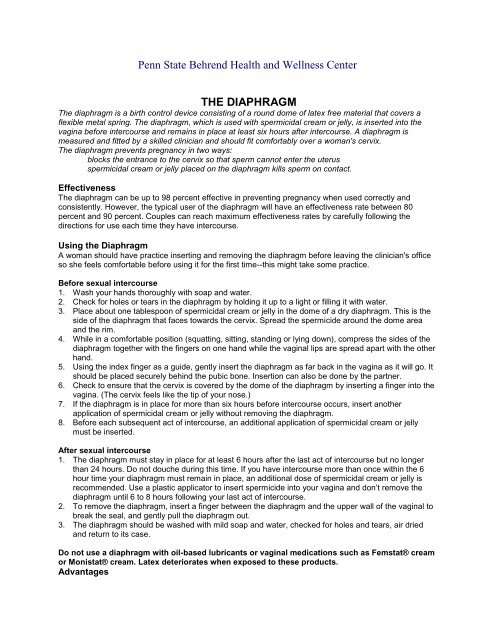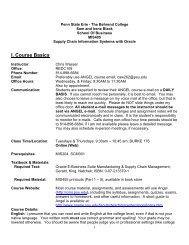Diaphragm - Penn State Erie
Diaphragm - Penn State Erie
Diaphragm - Penn State Erie
Create successful ePaper yourself
Turn your PDF publications into a flip-book with our unique Google optimized e-Paper software.
<strong>Penn</strong> <strong>State</strong> Behrend Health and Wellness Center<br />
THE DIAPHRAGM<br />
The diaphragm is a birth control device consisting of a round dome of latex free material that covers a<br />
flexible metal spring. The diaphragm, which is used with spermicidal cream or jelly, is inserted into the<br />
vagina before intercourse and remains in place at least six hours after intercourse. A diaphragm is<br />
measured and fitted by a skilled clinician and should fit comfortably over a woman's cervix.<br />
The diaphragm prevents pregnancy in two ways:<br />
blocks the entrance to the cervix so that sperm cannot enter the uterus<br />
spermicidal cream or jelly placed on the diaphragm kills sperm on contact.<br />
Effectiveness<br />
The diaphragm can be up to 98 percent effective in preventing pregnancy when used correctly and<br />
consistently. However, the typical user of the diaphragm will have an effectiveness rate between 80<br />
percent and 90 percent. Couples can reach maximum effectiveness rates by carefully following the<br />
directions for use each time they have intercourse.<br />
Using the <strong>Diaphragm</strong><br />
A woman should have practice inserting and removing the diaphragm before leaving the clinician's office<br />
so she feels comfortable before using it for the first time--this might take some practice.<br />
Before sexual intercourse<br />
1. Wash your hands thoroughly with soap and water.<br />
2. Check for holes or tears in the diaphragm by holding it up to a light or filling it with water.<br />
3. Place about one tablespoon of spermicidal cream or jelly in the dome of a dry diaphragm. This is the<br />
side of the diaphragm that faces towards the cervix. Spread the spermicide around the dome area<br />
and the rim.<br />
4. While in a comfortable position (squatting, sitting, standing or lying down), compress the sides of the<br />
diaphragm together with the fingers on one hand while the vaginal lips are spread apart with the other<br />
hand.<br />
5. Using the index finger as a guide, gently insert the diaphragm as far back in the vagina as it will go. It<br />
should be placed securely behind the pubic bone. Insertion can also be done by the partner.<br />
6. Check to ensure that the cervix is covered by the dome of the diaphragm by inserting a finger into the<br />
vagina. (The cervix feels like the tip of your nose.)<br />
7. If the diaphragm is in place for more than six hours before intercourse occurs, insert another<br />
application of spermicidal cream or jelly without removing the diaphragm.<br />
8. Before each subsequent act of intercourse, an additional application of spermicidal cream or jelly<br />
must be inserted.<br />
After sexual intercourse<br />
1. The diaphragm must stay in place for at least 6 hours after the last act of intercourse but no longer<br />
than 24 hours. Do not douche during this time. If you have intercourse more than once within the 6<br />
hour time your diaphragm must remain in place, an additional dose of spermicidal cream or jelly is<br />
recommended. Use a plastic applicator to insert spermicide into your vagina and don’t remove the<br />
diaphragm until 6 to 8 hours following your last act of intercourse.<br />
2. To remove the diaphragm, insert a finger between the diaphragm and the upper wall of the vaginal to<br />
break the seal, and gently pull the diaphragm out.<br />
3. The diaphragm should be washed with mild soap and water, checked for holes and tears, air dried<br />
and return to its case.<br />
Do not use a diaphragm with oil-based lubricants or vaginal medications such as Femstat® cream<br />
or Monistat® cream. Latex deteriorates when exposed to these products.<br />
Advantages
. Highly effective when used correctly<br />
. Dangerous side effects are rare<br />
. Used only when needed<br />
. Helps a woman become more familiar with her body<br />
. Intercourse does not have to be interrupted since the diaphragm can be inserted up to six hours<br />
before intercourse or inserted as part of foreplay<br />
. May offer some protection against certain sexually transmissible infections (STIs)
Potential Disadvantages<br />
. Must be used with each act of intercourse<br />
. May interfere with sexual spontaneity<br />
. Must be used with spermicidal cream or jelly each time<br />
. Rare allergies to latex rubber or spermicide<br />
. May put some women at increased risk for urinary tract infections and vaginitis<br />
. Possible risk of Toxic Shock Syndrome if left in place more than 24 hours<br />
We encourage you to talk further with your clinician to help you decide if the diaphragm is right for you.<br />
Availability and Cost<br />
A woman must be fitted for a diaphragm by a trained clinician. The clinician uses sample rings or<br />
diaphragms to determine the proper size diaphragm for each woman and a prescription is then written.<br />
During the fitting, the clinician will give instructions for proper insertion and removal techniques.<br />
Appointments<br />
Appointments can be made in person or by phone. If you are unable to keep your appointment, please call and<br />
Cancel. Otherwise you will be charged for the visit.<br />
To schedule or cancel appointments, call: (814) 898-6217<br />
For more information about health care issues, visit the Health and Wellness Center Web site at<br />
http://www.erie.psu.edu/student/health/index.htm<br />
This publication is available in alternative media on request.<br />
Soc_Abstinence_010103 Approved by Patient Education Committee: 01/01/03<br />
This content is reviewed periodically and is subject to change as new health information becomes available.<br />
This information is intended to inform and educate and is not a replacement for medical evaluation, advice,<br />
diagnosis or treatment by a healthcare professional.
















